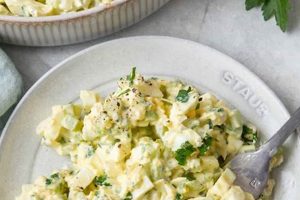A simple preparation involving cooked eggs, mayonnaise, and seasonings, combined and typically served between slices of bread, exemplifies this culinary staple. Variations often include mustard, chopped celery, onion, relish, or spices such as paprika or black pepper. This easily customizable dish offers a quick and affordable meal option.
Providing a good source of protein and adaptable to individual tastes and dietary needs, such a straightforward dish holds a prominent place in many cultures. Its affordability and ease of preparation have established its role as a popular lunch, snack, or picnic food. Historical variations demonstrate the adaptable nature of the dish, evolving from elaborate presentations to simpler versions reflecting economic and societal shifts.
This examination will delve into the various components and techniques for crafting this classic dish, exploring tips for optimal egg cooking, mayonnaise selection, flavor enhancements, and creative presentation. Further discussion will encompass variations accommodating dietary restrictions and nutritional considerations.
Tips for Crafting an Excellent Egg Salad Sandwich
Achieving optimal flavor and texture in an egg salad sandwich requires attention to detail in ingredient selection and preparation. The following tips offer guidance for creating a superior culinary experience.
Tip 1: Perfect Egg Cooking: Overcooked eggs can result in a dry, crumbly texture. Aim for a firm yet moist yolk by simmering eggs for 8-10 minutes, followed by immediate immersion in ice water to halt the cooking process.
Tip 2: Mayonnaise Selection: Mayonnaise serves as the binding agent and contributes significantly to the overall flavor profile. Experimenting with different types, such as olive oil-based or flavored varieties, can elevate the final product. The amount used can be adjusted for desired creaminess.
Tip 3: Enhancing Flavor Complexity: Incorporating finely chopped celery, red onion, or fresh herbs like dill or chives introduces textural and flavor complexity. A dash of Dijon mustard adds a tangy dimension.
Tip 4: Seasoning Appropriately: Salt and freshly ground black pepper are essential seasonings. A pinch of paprika or smoked paprika can impart a subtle smoky nuance.
Tip 5: Bread Choice Considerations: The bread provides the foundation of the sandwich. Hearty bread like sourdough or whole wheat holds up well to the filling. Lightly toasting the bread prevents sogginess.
Tip 6: Texture Considerations: For a smoother texture, use a potato masher or fork to achieve the desired consistency. For a chunkier texture, coarsely chop the eggs.
Tip 7: Proper Storage: Store prepared egg salad in an airtight container in the refrigerator for up to 3 days. This ensures food safety and maintains freshness.
By applying these techniques, one can elevate a simple egg salad sandwich to a truly satisfying and flavorful meal. Attention to detail in each step contributes to the overall quality and enjoyment of this classic dish.
Following these guidelines allows for a personalized and consistently delicious experience, demonstrating the versatility and appeal of this culinary staple.
1. Hard-boiled Eggs
Hard-boiled eggs constitute the foundational ingredient of a basic egg salad sandwich recipe. Their preparation and characteristics significantly influence the final dish’s quality, texture, and overall appeal. Understanding the nuances of cooking and incorporating hard-boiled eggs is essential for a successful outcome.
- Cooking Method:
Properly cooked eggs are crucial. Overcooking leads to dry, chalky yolks and an unpleasant sulfurous odor, while undercooking results in a runny, unappetizing texture. Ideal hard-boiled eggs feature firm, yet moist yolks and fully set whites. Achieving this requires precise timing and controlled cooling.
- Peeling Process:
Ease of peeling directly impacts preparation efficiency. Factors influencing peelability include egg freshness and cooking method. Older eggs generally peel more easily. Techniques like adding baking soda or salt to the boiling water, shocking the eggs in ice water, or gently rolling them on a flat surface can aid in removing the shell cleanly.
- Yolk Consistency:
The yolk’s texture contributes significantly to the final egg salad’s consistency. A slightly soft, creamy yolk creates a richer, smoother emulsion when mixed with mayonnaise and other ingredients. Overcooked yolks result in a drier, crumblier salad, while undercooked yolks lead to an excessively wet mixture.
- Flavor Contribution:
While seemingly neutral, the flavor of hard-boiled eggs provides a subtle backdrop for other ingredients. Their mild taste allows the seasonings and additions to shine without being overpowering. The inherent richness of the yolk lends depth to the overall flavor profile of the egg salad.
The careful preparation of hard-boiled eggs directly translates to a superior egg salad sandwich. Attention to cooking time, cooling method, and peeling technique ensures optimal texture and flavor, ultimately impacting the overall enjoyment of this classic dish.
2. Mayonnaise
Mayonnaise constitutes a crucial element in a basic egg salad sandwich recipe, serving as both a binding agent and a significant flavor contributor. Its quality, type, and quantity significantly influence the final product’s texture, taste, and overall appeal. Understanding mayonnaise’s role is essential for crafting a successful egg salad sandwich.
- Emulsification and Binding:
Mayonnaise’s primary function lies in its ability to emulsify and bind the other ingredients. The emulsification process, facilitated by lecithin in egg yolks, combines oil and water, creating a stable, creamy mixture that holds the chopped eggs, seasonings, and any additional components together. This prevents the salad from becoming watery or separating, ensuring a cohesive texture.
- Flavor Profile:
Mayonnaise contributes significantly to the overall flavor profile of the egg salad. Its inherent richness, derived from oil and egg yolks, complements the mild flavor of the eggs. Different types of mayonnaise, such as those made with olive oil, avocado oil, or flavored with herbs and spices, can further enhance the taste, adding depth and complexity.
- Texture and Consistency:
The amount of mayonnaise used directly impacts the egg salad’s texture and consistency. A greater quantity results in a creamier, smoother salad, while less mayonnaise produces a chunkier, denser mixture. The desired consistency depends on individual preference and intended use, such as spreading on bread or crackers.
- Quality Considerations:
The quality of mayonnaise used affects the final product’s taste and overall quality. Higher-quality mayonnaise typically contains better ingredients, resulting in a richer, more nuanced flavor. Ingredients like preservatives and stabilizers can impact taste, so opting for simpler, more natural options may yield a superior result.
Mayonnaise’s impact extends beyond simply holding the egg salad together. It plays a multifaceted role, influencing texture, taste, and overall quality. Careful consideration of mayonnaise selection is therefore essential to achieving a well-balanced and enjoyable egg salad sandwich experience.
3. Seasoning
Seasoning plays a critical role in elevating a basic egg salad sandwich from simple sustenance to a flavorful culinary experience. The judicious application of seasonings enhances the inherent flavors of the eggs, mayonnaise, and any additional ingredients, creating a balanced and palatable final product. Understanding the function and impact of various seasonings is essential for crafting a truly satisfying egg salad sandwich.
- Salt:
Salt serves as the foundational seasoning, enhancing the natural flavors of the other ingredients. It amplifies the richness of the egg yolks and balances the tanginess of the mayonnaise. The correct amount of salt is crucial; too little leaves the salad bland, while too much renders it unpalatable.
- Black Pepper:
Black pepper adds a subtle heat and complexity to the egg salad. Freshly ground black pepper offers a more pronounced and vibrant flavor compared to pre-ground pepper. The coarseness of the grind can be adjusted to preference, with finer grinds blending seamlessly and coarser grinds offering a more assertive texture.
- Other Spices and Herbs:
Beyond salt and pepper, a range of other spices and herbs can enhance the flavor profile of the egg salad. Paprika adds a smoky sweetness, while dill or chives contribute a fresh, herbaceous note. Mustard powder introduces a tangy complexity. Experimentation with different spice combinations can yield unique and personalized flavor profiles.
- Balancing Flavors:
The key to successful seasoning lies in achieving a harmonious balance. The goal is to complement and enhance the existing flavors, not to overpower them. A careful approach, starting with small amounts and tasting incrementally, ensures the desired balance and prevents over-seasoning. The interplay between salt, pepper, and other spices creates a cohesive and flavorful final product.
Seasoning is not merely an afterthought; it is an integral component of a well-crafted egg salad sandwich. The thoughtful application of seasonings elevates the dish beyond its basic components, transforming it into a truly satisfying culinary creation. The careful balance of salt, pepper, and other spices or herbs creates a symphony of flavors that harmonize with the eggs and mayonnaise, delivering a delightful and memorable dining experience.
4. Bread
Bread serves as the structural foundation of the basic egg salad sandwich, playing a crucial role beyond simply containing the filling. Its characteristics significantly influence the overall sensory experience, affecting texture, flavor, and practicality. The choice of bread directly impacts how the sandwich holds up, how the flavors meld, and the overall enjoyment of the meal.
Different bread types offer varying levels of structural integrity. A delicate white bread might become soggy under the weight and moisture of the egg salad, while a denser, sturdier bread like sourdough or whole wheat maintains its shape and texture. This structural integrity is vital for portability and ease of consumption. Consider a picnic scenario: a sandwich on flimsy bread is likely to fall apart, while a sandwich on robust bread remains intact, offering a more manageable and enjoyable eating experience. The bread’s absorbency also plays a role; overly absorbent bread can become saturated and lose its appeal. The flavor profile of the bread interacts with the egg salad filling. A neutral-flavored bread allows the flavors of the egg salad to shine, while a more assertive bread, like rye or pumpernickel, adds another dimension to the overall taste. The bread’s texture also contributes to the eating experience, contrasting with the creamy filling to create a pleasing textural interplay.
Appropriate bread selection elevates the basic egg salad sandwich from a simple combination of ingredients to a well-composed culinary creation. Structural integrity, flavor compatibility, and textural contrast are key considerations. Choosing bread that complements the egg salad ensures a cohesive and enjoyable eating experience, highlighting the importance of bread as a fundamental component of this classic dish.
5. Mix-ins (optional)
While a basic egg salad sandwich thrives on simplicity, optional mix-ins offer opportunities to personalize flavor and texture, elevating the dish beyond its fundamental components. These additions, ranging from crunchy vegetables to savory spices, introduce complexity and create opportunities for culinary creativity. The impact of mix-ins extends beyond mere flavor enhancement; they contribute to the overall sensory experience, influencing texture, aroma, and visual appeal.
Consider the addition of finely diced celery. Its crisp texture contrasts with the creamy egg salad, providing a refreshing counterpoint. Chopped red onion introduces a pungent bite, while fresh herbs like dill or chives contribute a bright, herbaceous note. Sweet pickle relish adds a tangy sweetness, balancing the richness of the mayonnaise. Incorporating chopped walnuts or pecans provides a satisfying crunch and nutty flavor. Even a sprinkle of smoked paprika or a dash of hot sauce can dramatically alter the flavor profile, adding depth and complexity. These additions, while optional, allow for customization based on individual preferences, dietary needs, and seasonal availability.
The practical significance of understanding the role of mix-ins lies in the ability to tailor the egg salad sandwich to specific tastes and occasions. A simple egg salad, seasoned with salt and pepper, suits a quick lunch. A more elaborate version, incorporating various vegetables, herbs, and spices, might be appropriate for a picnic or potluck. The versatility afforded by mix-ins allows the basic egg salad sandwich to transcend its humble origins, transforming into a culinary canvas for creative expression. Careful consideration of mix-ins allows one to craft a truly personalized and satisfying culinary experience, demonstrating the adaptable nature of this classic dish.
6. Preparation Method
Preparation method significantly influences the final quality and enjoyment of a basic egg salad sandwich. While seemingly straightforward, the techniques employed in combining ingredients directly impact the texture, flavor distribution, and overall appeal. Understanding these nuances elevates the outcome from a simple mixture to a carefully crafted culinary creation.
- Egg Chopping Technique:
The size and uniformity of the chopped eggs affect both texture and flavor perception. Coarsely chopped eggs create a chunkier, more rustic texture, while finely chopped eggs yield a smoother, more homogenous consistency. Uniformity ensures even distribution of flavor and prevents pockets of plain egg or excessive mayonnaise. The chosen technique influences the mouthfeel and how the flavors meld.
- Ingredient Incorporation:
The order and manner in which ingredients are combined impacts the final product. Gently folding the mayonnaise into the chopped eggs prevents overmixing, which can lead to a dense, paste-like texture. Adding seasonings gradually, tasting incrementally, ensures balanced flavor distribution and prevents over-seasoning. Proper incorporation techniques maintain the integrity of individual ingredients while creating a cohesive mixture.
- Chilling Time:
Chilling the prepared egg salad allows the flavors to meld and develop. This resting period enhances the overall taste experience, as the ingredients harmonize. Chilling also firms the mixture, making it easier to spread on bread and preventing excessive dripping. The duration of chilling can be adjusted based on individual preference and time constraints.
- Proportion and Balance:
The ratio of eggs to mayonnaise and other mix-ins significantly affects the final products moisture content, flavor intensity, and overall appeal. Too much mayonnaise results in a runny, overly rich salad, while too little yields a dry, crumbly mixture. Achieving the correct balance creates a harmonious blend of flavors and textures, maximizing enjoyment. Experimentation and personal preference guide optimal proportions.
Careful attention to preparation methods elevates the basic egg salad sandwich. From egg chopping techniques to ingredient incorporation, chilling time, and ingredient proportions, each step contributes to the final product’s quality and appeal. Understanding and applying these nuances transforms a simple assembly process into a culinary endeavor, demonstrating the importance of technique in even the most basic recipes.
Frequently Asked Questions
This section addresses common inquiries regarding the preparation and enjoyment of egg salad sandwiches, offering concise and informative responses to clarify potential uncertainties.
Question 1: How long can prepared egg salad be safely stored?
Prepared egg salad should be stored in an airtight container in the refrigerator for no longer than three to five days. Beyond this timeframe, the risk of bacterial growth increases significantly.
Question 2: What are signs that egg salad has spoiled?
Spoilage indicators include a sour odor, discoloration, or a slimy texture. If any of these signs are present, the egg salad should be discarded immediately.
Question 3: Can egg salad be frozen?
Freezing egg salad is not recommended. The mayonnaise-based emulsion breaks down during freezing and thawing, resulting in an undesirable texture upon reconstitution.
Question 4: How can one prevent a runny egg salad?
A runny consistency often results from excessive mayonnaise or insufficiently drained hard-boiled eggs. Using less mayonnaise and ensuring the eggs are thoroughly dried after cooking helps prevent this issue.
Question 5: What are suitable alternatives to mayonnaise?
Alternatives to mayonnaise include plain Greek yogurt, avocado, or hummus. These options offer different flavor profiles and varying degrees of creaminess, allowing for customization based on dietary preferences or desired taste outcomes.
Question 6: How can one achieve perfectly hard-boiled eggs for egg salad?
Achieving perfectly hard-boiled eggs involves simmering eggs for 8-10 minutes, followed by immediate immersion in ice water to halt the cooking process. This method ensures a firm yet moist yolk and facilitates easy peeling.
Addressing these common queries aims to provide a comprehensive understanding of egg salad preparation and storage. Adhering to safe food handling practices and utilizing appropriate preparation techniques ensures a satisfying and enjoyable culinary experience.
For further exploration, the following section delves into variations and adaptations of the classic egg salad sandwich recipe, catering to diverse dietary preferences and culinary aspirations.
Conclusion
Exploration of the basic egg salad sandwich recipe reveals a dish deceptively simple in composition yet nuanced in execution. From the precise cooking of eggs to the careful selection of mayonnaise, seasonings, bread, and optional mix-ins, each component contributes significantly to the final product. Proper preparation techniques, including chopping, mixing, and chilling, further influence texture, flavor development, and overall enjoyment. Addressing common queries regarding storage, spoilage, and ingredient substitutions provides a comprehensive understanding of this culinary staple.
The basic egg salad sandwich recipe, while classic in its simplicity, offers a platform for culinary creativity and personal expression. Adaptability to individual tastes and dietary preferences ensures its enduring appeal across generations and cultures. Continued exploration of variations and flavor combinations promises further evolution of this versatile dish, solidifying its place as a timeless culinary creation.






